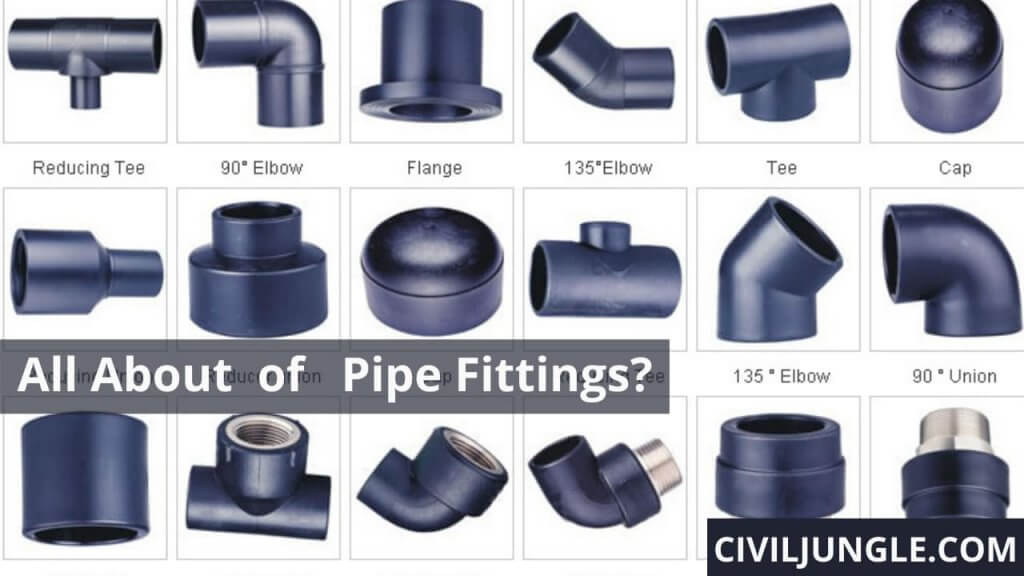
What Is Pipe Fittings?
Pipe fittings are the process where we divert the flow of the water by using piping components like tees, elbows, etc. In pipe fittings, we change the pipe sizes by using reducing tees, reducers, etc. Here, we use coupling to connect the flow of water and caps to stop the water.
Types of Pipe Fittings
There are different types of joints are available, those are.
- Cross, Tee, Wye and Elbow Fittings
- Tee & Wye Fittings
- Cross Fittings
- Elbow Fittings
- Adapter, Bushing, Coupling and Union Fittings
- Coupling and Adapter Fitting
- Bushing Fittings
- Union Fittings
- Flange and Trap Fittings
- Trap Fittings
- Flange Fittings
- Plug, Cap, Nipple Fittings
- Cap Fittings
- Plug Fittings
- Nipple Fittings
1. Cross, Tee, Wye and Elbow Fittings
The list of cross, tee, wye and elbow fittings are as follows.
1.1. Tee & Wye Fittings

This type of joint is used to connect three pipes. Here, one inlet is there and two outlets, these are available in the 90-degree bend which is shape of English letter ‘T’.
This is used to split the water flow into two parts or join the two water flows into one. The shape of Wye is like English letter ‘Y’ which is basically a 45-degree bend and it is used in drain application.
A Wye has two inlets and one outlet. The side pipe of Wye is used to release the sewer gases in upward direction.
1.2 Cross Fittings
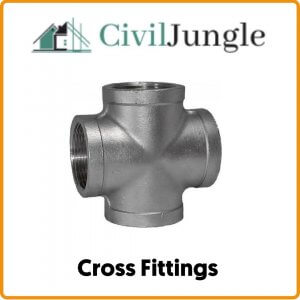
This type of fitting has four openings and here it is used as three inlets and one outlet or three outlets and one inlet. It is generally used in sprinkler systems or irrigation systems.
1.3 Elbow Fittings
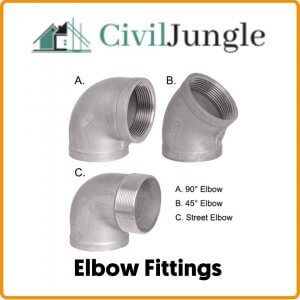
This fittings have one opening and it has different bends of 90 degrees, 45 degrees, 60 degrees and 22.5 degrees. Elbow fitting is used to avoid obstructions in the pipe run.
2. Adapter, Bushing, Coupling and Union Fittings
The list of adapter, bushing, coupling and union fittings are as follows.
2.1 Coupling and Adapter Fitting
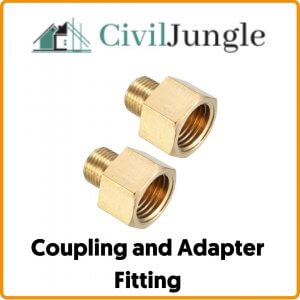
Coupling is used to connect two pipes, which slips over it and connects permanently. It is generally used to connect a large size pipe with a small one. Adapters are connected when different types of pipes are there like one is a normal pipe and other one is a threaded pipe.
2.2 Bushing Fittings
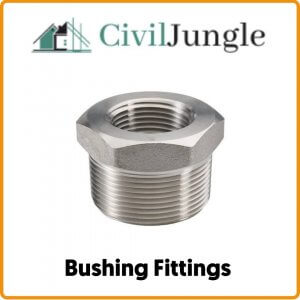
A bushing is used to reduce the pipe fitting because the inlet of this is large and outlet is small; that’s why it is called reducer bushing.
2.3 Union Fittings
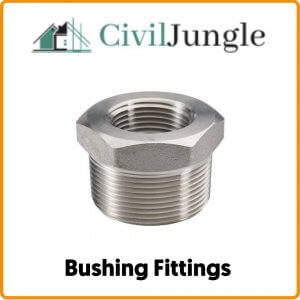
Unions connect two same pipes by threaded rings or nuts. We can easily disconnect the connection by loosening the rings or nuts which is not possible in the coupling.
3. Flange and Trap Fittings
The list of flange and trap fittings are as follows.
3.1 Trap Fittings
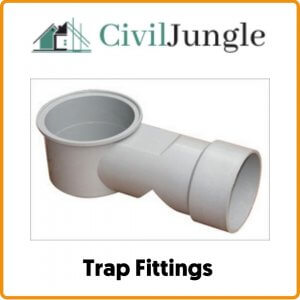
Trap is basically a horizontal bend which is fitted in the drainage system of the kitchen or bathroom. The shape of traps are generally ‘U’ and ‘P’ shaped. The traps contain water which is used as the barrier which prevents entering the sewer gases.
3.2 Flange Fittings

Flange fittings are flat fittings which used to seal by using clamps or bolts. This is used through walls, floors, ceilings, etc.
4. Plug, Cap, Nipple Fittings
The list of plug, cap, nipple fittings are as follows.
4.1 Cap Fittings

This is generally used to stop the flow of the flowing materials. This is temporally used to stop when the plumbing work is ongoing.
4.2 Plug Fittings
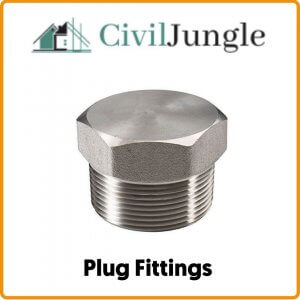
Plus settings are used at the end of the pipe. A plug is only fits with a threaded pipe.
4.3 Nipple Fittings
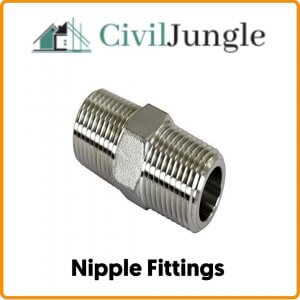
It is a small section of male threaded which connects with two female thread.
Different Types of Pipe Fittings in Plumbing Related Viedo
FAQ
What Are Pipe Fittings and Why Are They Important?
Pipe fittings are components used to connect, divert, and change the direction or size of pipes in a plumbing or piping system. They are essential for ensuring the proper flow and management of fluids, gases, or other substances through pipes.
What Types of Pipe Fittings Are There?
Pipe fittings come in various types, including:
- Cross, Tee, Wye, and Elbow Fittings: Used to connect multiple pipes and change the direction of flow.
- Adapter, Bushing, Coupling, and Union Fittings: Used to join different pipe sizes and types or facilitate easy disconnection.
- Flange and Trap Fittings: Used for sealing and trapping water to prevent sewer gases from entering.
- Plug, Cap, and Nipple Fittings: Used to close off ends or connect sections of pipe.
What Is the Difference Between a Tee and a Wye Fitting?
A tee fitting connects three pipes in a ‘T’ shape, typically used to split or join water flow. A wye fitting, shaped like a ‘Y,’ is used for a smoother transition between pipes and is often used in drain applications.
When Should I Use an Elbow Fitting?
Elbow fittings are used to change the direction of pipe runs. They come in various angles, such as 90 degrees or 45 degrees, to navigate around obstructions or alter the flow path.
What Is the Purpose of Coupling and Adapter Fittings?
Couplings connect two pipes of the same diameter, while adapters connect pipes of different types or sizes, such as threaded and non-threaded pipes.
How Do Bushing Fittings Work?
Bushings are used to reduce the size of a pipe fitting, with a larger inlet and a smaller outlet, effectively transitioning between different pipe sizes.
What Is the Function of a Union Fitting?
Union fittings connect two pipes with threaded rings or nuts, allowing for easy disconnection without cutting the pipes, unlike couplings.
What Are Trap Fittings Used For?
Trap fittings, often shaped like a ‘U’ or ‘P,’ are used in drainage systems to hold water, which acts as a barrier to prevent sewer gases from entering the living space.
How Do Flange Fittings Differ from Other Types of Fittings?
Flange fittings are flat components that seal connections using clamps or bolts and are commonly used for connecting pipes through walls, floors, or ceilings.
What Are Plug and Cap Fittings Used For?
Cap fittings are used to temporarily stop the flow of materials during plumbing work, while plug fittings are used to seal the end of a threaded pipe.

